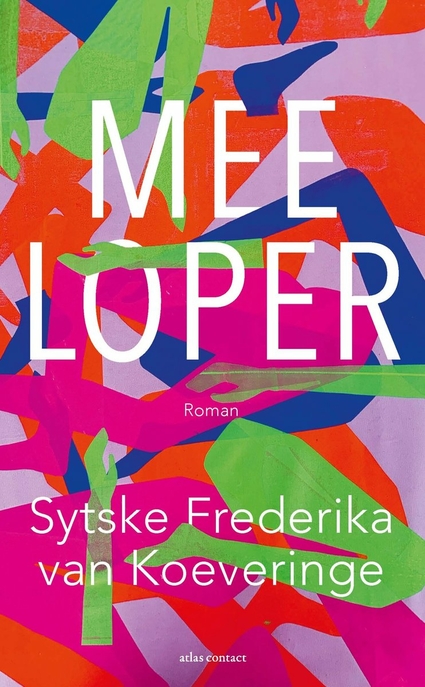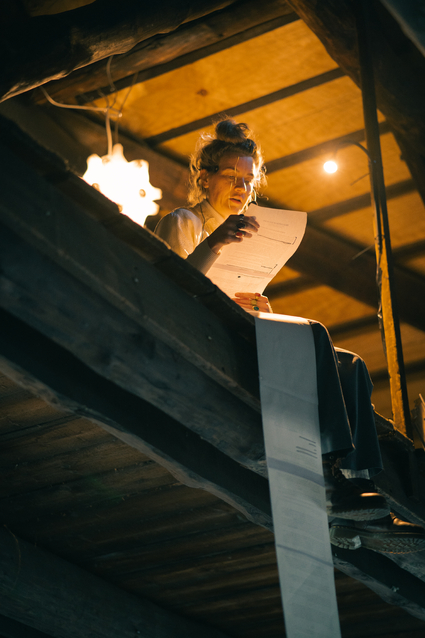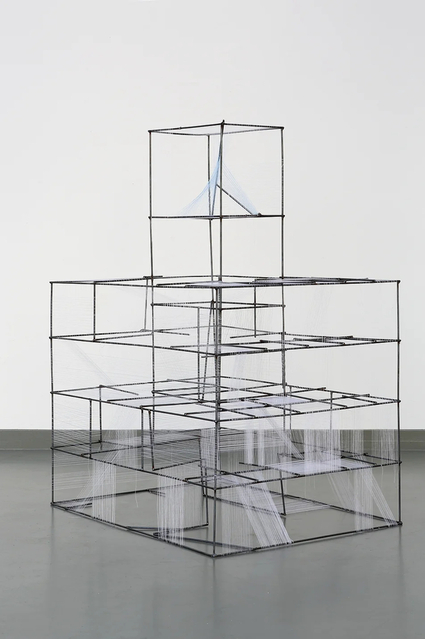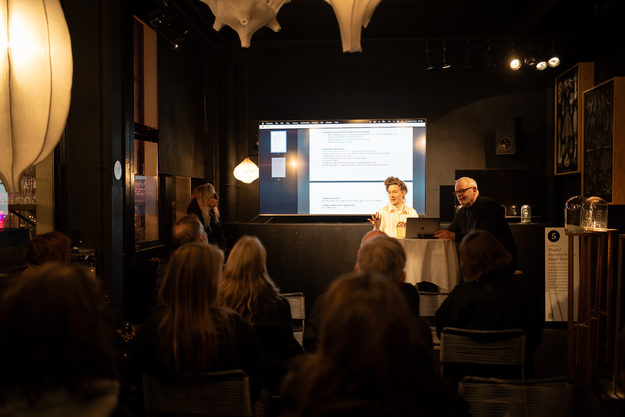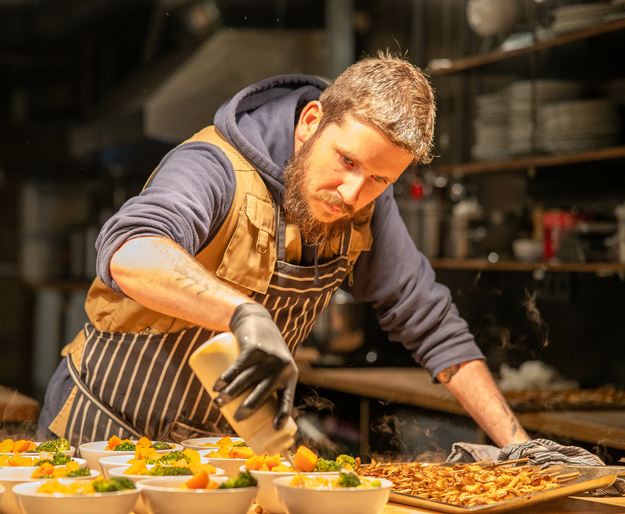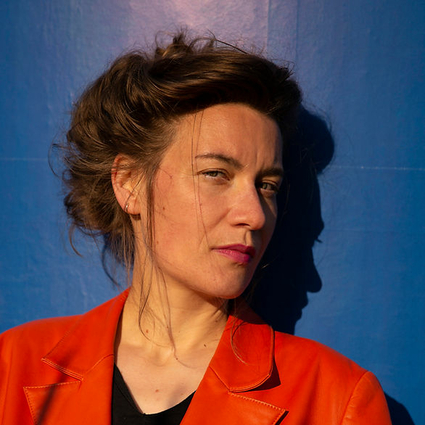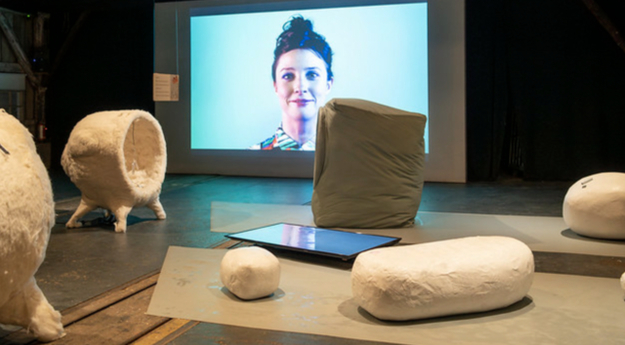Excerpts from Meeloper
In Meeloper, Sytske humorously illuminates the ways work is intertwined with all aspects of our lives, and what value it holds in our society.
How did we reach a point where work is taken for granted, and how does work relate to art and love? Meeloper is narrated by Sytske’s alter-ego Sien, whom we follow as she tags along with people from many different professions and investigates whether she can unravel the working system. This investigation culminates in the founding of the fictional all-encompassing company The Official Naturalness, which sells manuals for all the things we take for granted: breathing, sitting, scrolling on our phones…
Translation
So far, Meeloper is only available in Dutch, but you can find a translation of the fragments Sytske read during this evening here to gain a better impression.
Q&A
The Official Naturalness
For the second half of the evening, guests regrouped in the Haeckel room for a Q&A session with Sytske moderated by the a/Artist curators Willem Velthoven and Annelies Wina Doom. They started out by discussing the website of The Official Naturalness, which, unlike the company itself, actually exists. Clicking through it, one is frequently interrupted by ‘inspirational quotes’ that pop up on the screen, such as: “Today is the first day of the rest of your life”.
“They are meant to be stupid slogans that say nothing”, Sytske explained, “like when you open your computer, and it says welcome back.”
On-structions
In Meeloper, the Official Naturalness sells instruction manuals, called ‘on-structions’, for all the things we usually take for granted. Some of these manuals are also available for download on the website, and are, of course, linked to one another: “Everything is connected to everything.”
Glass glass glass
Sytske also sketched and created a model for the sort of building The Official Naturalness is in, described in the book as follows: “Every building is made of glass, every wall, every door, table, chair, every pipe glass glass glass. […]. Working life as one great panopticon.“
Screen-printed employees
She continued: “Then I thought where there’s a building there must also be employees, ‘low-educated’ and ‘high-educated’ people, in quotation marks, because that’s not how we label people anymore, but I did want to make it all explicit in this company.” These employees are even listed by name on the website, and Sytske created abstract representations of them in the form of individual screen prints.
“It was interesting to observe the different postures people had as I was tagging along with them.”, she explained. “For example, people in offices were much stiffer, straighter, they didn’t allow as much spontaneity, and that’s what I wanted to show in the screen prints through colors and shapes.”
Do you want to know where you are headed in life?
One guest was curious about the tab labeled vacancies, and Sytske explained: “If you fulfill all the criteria, you get a direct registration for an interview.” The criteria, phrased as questions, are listed: “Are you 18 and in need of daily rhythm, routine and cleanliness? Do you want to know where you are headed in life? Do you want to be challenged every day?”, and many more.
Annelies noted: “When I read this I thought: you must give away everything when you register. It’s a bit like a monastery in that way. Would you say there is a connection?”
Sytske replied: “I did notice that people my age, at least in my bubble, focus way too much on their work, they make a lot of things depend on their work and it’s a bit like they almost forget to live. For example, when I want to meet a friend, it’s usually to get coffee three months from now because there is so little time. For The Official Naturalness, I just exaggerated a lot of things I noticed while tagging along and from observing expectations and attitudes about work in my myself and my own circle.
Choices and surprise
Annelies followed up: “When I read it, I thought that by exaggerating it like this you are not only talking about work but also about the choices we are making in general. You show how we participate in this system, often without thinking about it. Maybe many people don’t even realize that there are choices…”
Sytske disagreed: “I wouldn’t want to say that about people, my general impression is that they do know that there are choices.”
“Yet your book is about your surprise at people who keep making the choice over and over.”, Willem objected. “Yes, that is quite true”, Sytske admitted – “I think there’s a choice in the work you do, but of course your background and family can push you into a certain kind of work. Still, it surprises me that people then continue to choose to move within this space.”
As an example, she named the plumber, a notorious character in Meeloper: “He said it was logical for him to become a plumber because his father was also a plumber. That’s what I found surprising.”
Method writing
Willem continued: “In your book you describe many things you’ve tried out yourself. The book is about someone else, it’s about Sien, you are Sytske, there is some space between the two. But you did do all the tagging along, right?”
“Yes, for three years between 2015 and 2018.”, Sytske confirmed.
“It’s like method writing instead of method acting!”, Annelies commented.
Sytske also explained why she chose to fictionalize her accounts of this time: “When I started writing I thought I can’t literally write it down as myself, firstly because it’s just memories and secondly because it’s a freeing thing to not write as myself. Also, if I were to write down all the tag-along days from memory as myself, I position myself as an observer. I wanted to say something about hierarchies that exist within work and doing that would have meant that those hierarchies continue to exist, because I don’t give people the space to add to the conversation.”
Side-jobs and money
“What was your economic situation like while you were writing the book?”, a guest wanted to know.
“I’ve pretty much always been working”, Sytske replied – “My parents told me that if you want something you have to work for it and I took that quite literally, I always had a side job, many side jobs. When I started with this project, I was a cleaner three days a week so I could do my own work the rest of the time, and I still do that in a way, but not as a cleaner anymore. Of course, people work to afford a living. But I also wanted to think about taking money out of the equation.”
“When I read your book, I thought it was more about how work shapes peoples’ identities. That you are a plumber. The money aspect is always already there”, Willem reflected. “But it’s about how peoples’ posture changes when they transition in and out of work, like your favorite cashier who becomes a different person as she briefly steps outside her role.”
Sytske agreed that she was seeking out these kinds of subtle changes and repetitions in behavior in her process. “Everyone does it in their own way. That repetition fascinates me endlessly.”
What is your practice?
“Someone recently asked me: What is your practice?”, an audience member remembered. “Not ‘what is your job’, but your practice. So, I’m curious about Sien or about you, what is your practice?”
Sytske responded: “Sien’s practice, I think, is researching the fascination in repetitions. And my own… sometimes I see something and think this is it, but I get distracted very easily. I can intensely focus on something, but now the book is done, and I don’t know what my practice is anymore.”
History and future
“Does your book go into the political history of work at all, the ideological aspects?“, someone else wanted to know, and Sytske explained that while these topics are never addressed explicitly, there are details here and there about the history of work and craft, and how it shapes peoples’ lives today – “Like eating dinner at 6pm and how that is connected to work, but it’s a bit fragmentary.“
Another guest addressed the question of the future: “You were talking about waste collectors before, which is a career I have considered for myself, but realized that it’s one of the jobs that will soon be replaced by machines. Does your book go into the changing and disappearance of certain jobs?”
Again, Sytske clarified that the book does not delve into specific speculations about the future of work but does implicitly address ongoing changes. “Tagging along with the waste collectors, I had the romanticized idea that I’d be hanging at the back tossing garbage into the truck, but that’s not at all what it looks like anymore. Another example is Sien’s father asking ‘can’t you work with photoshop’ when she does screen prints. So, there are those small details.”
Friendly pallbearers
Annelies wanted to know about Sytske’s nicest experience while tagging along. “You mentioned before that it was with the pallbearers?”
“Yes!”, Sytske confirmed: “The stupidest experience was with the plumber, and the nicest one was with the pallbearers. I had heavy expectations for it, but the boss and the boys who worked for him were all very kind, so it was just a really gezellig day! We drove from Utrecht to the location of the funeral; they were all dressed up and we had nice conversations on the way. It was a relaxed atmosphere and I think personally that’s what I’m looking for in a job.”
Roles, functions, and purpose
Another guest asked from the audience: “I know a woman who works as a waste collector, and she really likes her job because it comes with knowing her role and function in society. And I was wondering how that’s for you with your work, knowing the context and function of your role in society? If Sien were to tag along with you, what would she see?”
Sytske considered this for a moment. “I don’t know where to start… it varies a lot. When I’m at Concertgebouw helping people with their tickets it’s very different from when I give writing lessons. And when I am writing, I reach a certain level of concentration that makes it feel like I’m not there at all. So, it jumps all the time. That’s why I find it annoying when someone asks, ‘what do you do’. Because if I say, ‘I’m an artist’, I end up in a weird conversation where the other person assumes that I sit and make art all day, a very romantic image, whereas I know that I am working really hard to be able to make what I want to make. When I am done with a project, it is followed by a period of nothing, and I’m in such a period now. So, asking about ‘what I am’ or what my function is right now – I’m not really sure, it’s not a very nice period. I prefer having something to hold onto.”
Intuitive and acquired noticing
“Something that stood out to me about the book were all the details interwoven in it”, Willem said. “Would you say that’s because you notice so many things?”
Sytske considered this: “I tried to make it sensory, it’s something I also teach in writing classes. You can write the loveliest sentences, but the reader feels nothing unless you add sensory details. I do it subconsciously, it’s not something I learned.”
“Did you already experience this as a child?”, someone else inquired – “Noticing a lot of things?”
“I think so”, Sytske reflected. “My mother gave me a diary very early on, saying I don’t know what is going on in your head, but put it in here and it will be okay. And I was very industrious with it, I still have those diaries and I never really stopped. So that started early, and luckily my parents made space for it.”
“You also mentioned that your mother ‘sent you’ to art school”, Willem recalled.
“Yes”, Sytske confirmed. “I did VBO and thought I’d stop after that, but my mother insisted I had to continue and eventually go to art school. High school was terrible, but eventually my mother took me to the art school open days, and I thought oh, this is where everybody is. Now, it will be okay.”
Exploring neurodivergence
Finally, Willem mentioned Sytske’s connection to the topic of neurodivergence. “When we asked you to speak here you said you don’t understand how the a/Artist project is related to you. But reading the book, Annelies and I thought check, check, check…”
In the character Sien, they found characteristics like detailed noticing, hyperfocus, and a certain quizzical alienation from and at the same time intense curiosity about societal conventions which they took as indications of a neurodivergent mind.
“So, we said, maybe you don’t have a connection – but Sien does!”, Annelies remembered. “Yeah, that was funny”, Sytske said – “And it’s something I am incidentally starting to investigate now. I’m curious where that will lead, and I do recognize myself in your stories and experiences – I just never knew there was a word for it and people who know what it is.”
